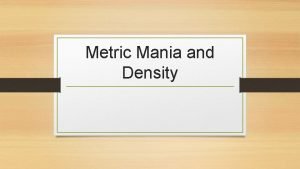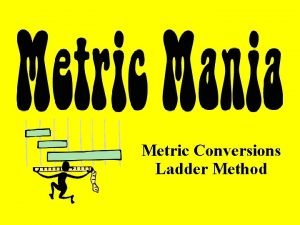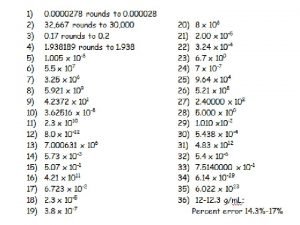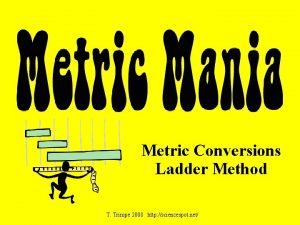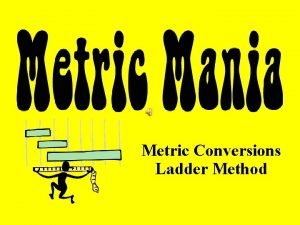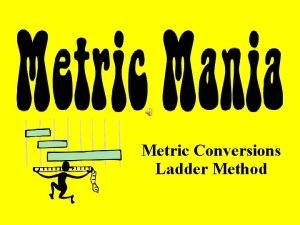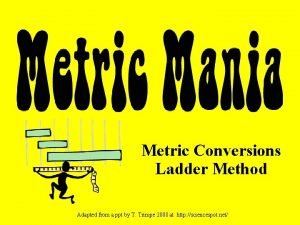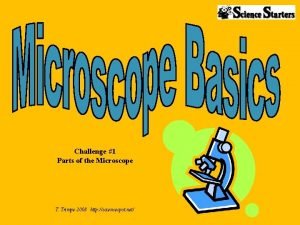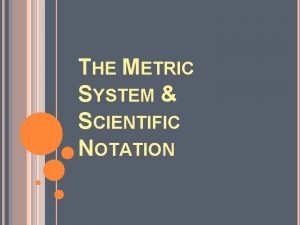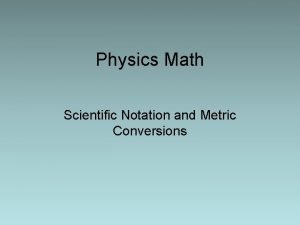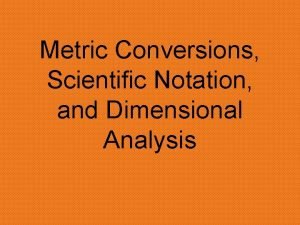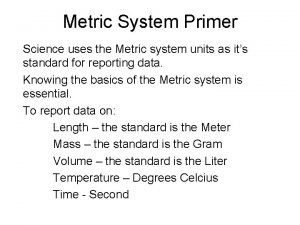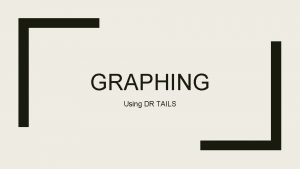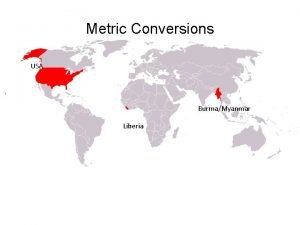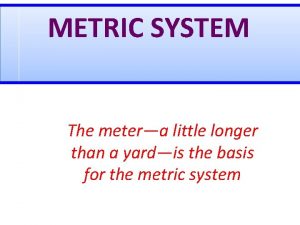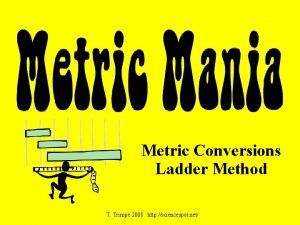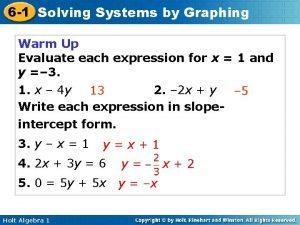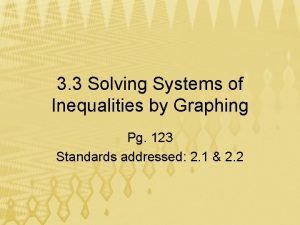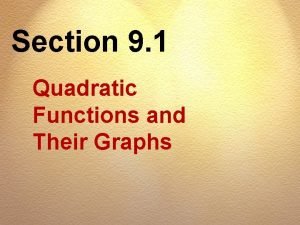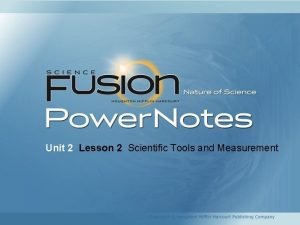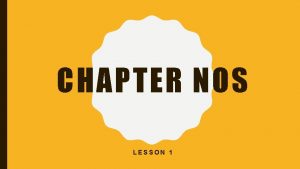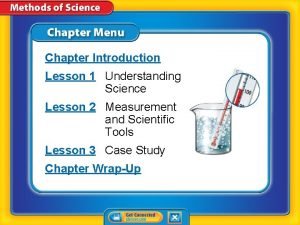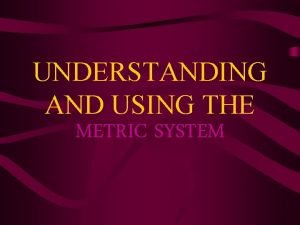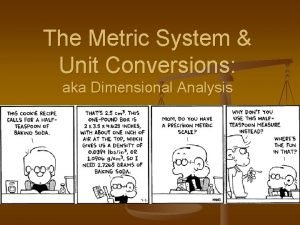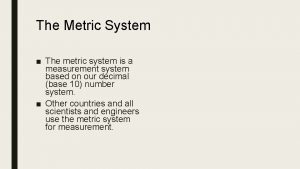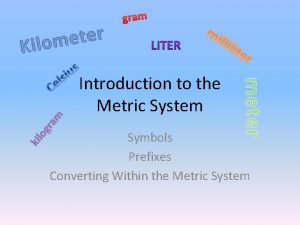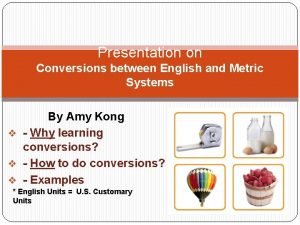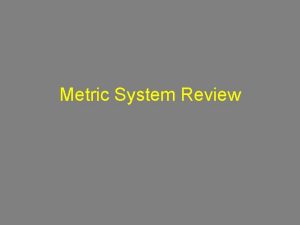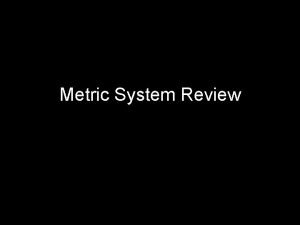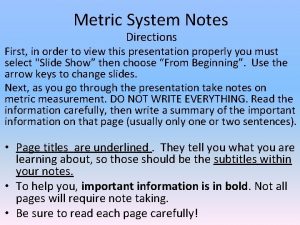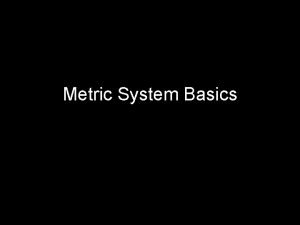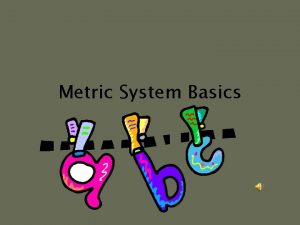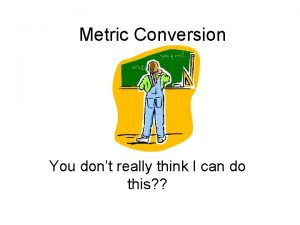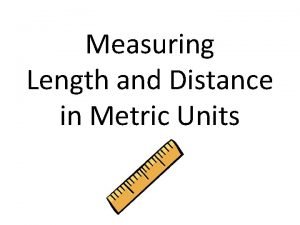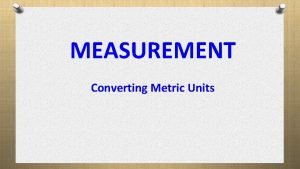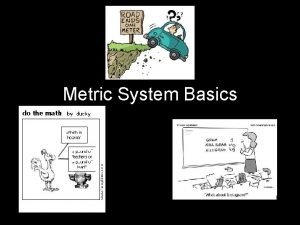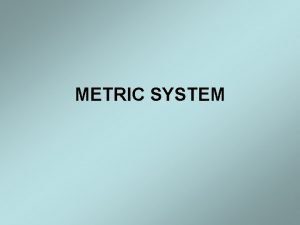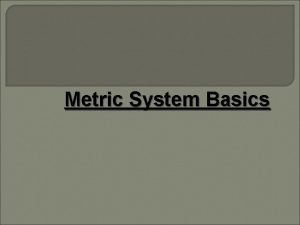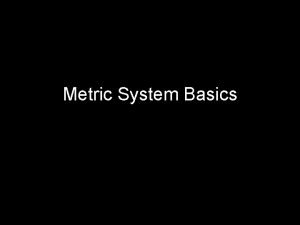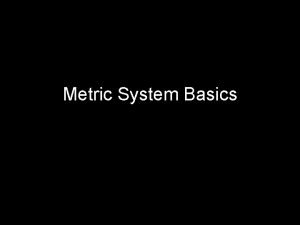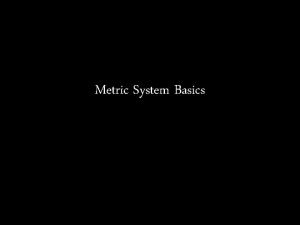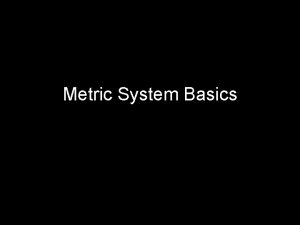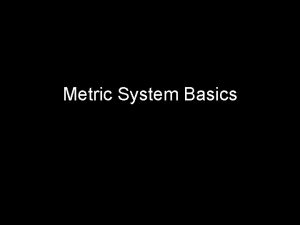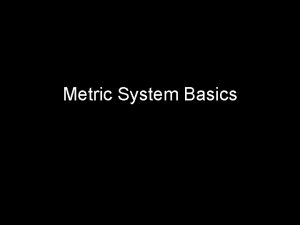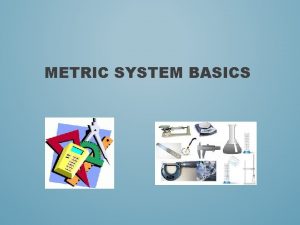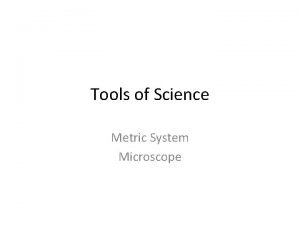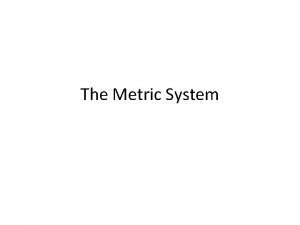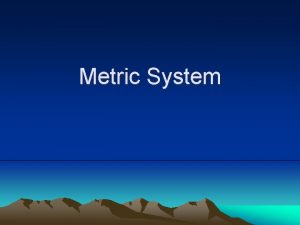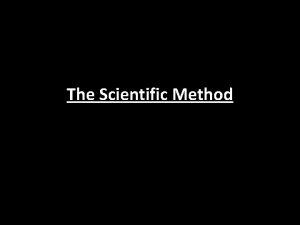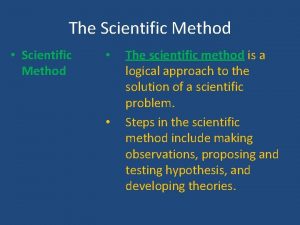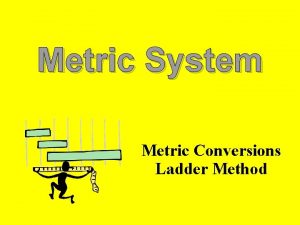Scientific Method Metric System Graphing Tools Microscope Tools















































- Slides: 47

Scientific Method Metric System Graphing Tools Microscope

Tools l l l Magnifying glass Scissors (#16) Thermometer (#5) Flask (#9) Graduated cylinder (#7) Beaker (#8) Pipette (#19) Triple Beam Balance Metric ruler (#6) Safety goggles (#4) Forceps (#17) Petri dish (#15)

Scientific Method l Scientific method: method a process by which scientists do experimental research l 6 steps l l l State the problem Forming a hypothesis Experiment Collect and record data Analyze Conclude

Step #1: State the problem and Research l l l Question something Want to figure something out Must do Research – this depends on the experiment

Step #2: Form a Hypothesis l l l An educated guess based on prior knowledge Must be able to be tested Format: l If…. . then…. .

Page 11 Variables l l (add to notes) A factor that changes in an experiment 2 types l l Independent: the variable that is purposely changed or manipulated Dependent: the variable that responds to the IV Constants: all factors that remain the same and have a fixed value Control: the standard factor used for comparing experimental effects

In a science fair, Jordan asks the question “Does caffeine increase the heart rate of an earthworm? ” In Test 1, he measures the heart rate by looking at the earthworm under a microscope, the earthworm has a heart rate of 50 bpm (beats per minute). In Test 2, he places a few drops of caffeine on the earthworm’s skin and measures the rate again. In this test, the heart rate is 68 bpm. 1) What is the control group? 2) What is the IV? 3) What is the DV? 4) What should Jordan’s conclusion be? 5) Jordan needs to repeat the experiment, but his teacher says that he needs to improve his design. In his second experiment, what should he do differently.

Find the IV, DV, control and constants l Does heating a cup of water allow it to dissolve more sugar? l What are the effects of the amount of pollution produced by cars using gasoline containing different amounts of lead? l Two groups of students were tested to compare their speed working math problems. Each group was given the same problems. One group used calculators and the other group computed without calculators.

Pg 12 Variable Practice l Complete l l IV DV Control Contstants 3

Step #3: Experiment l The process of testing a hypothesis by carrying out data-gathering procedures under controlled conditions l Must have l Material’s List § § l Be sure to have amounts and quantities In a list format Procedure § § Very detailed In a numbered list format

Step 4: Collect & Record Data l l This is the experiments results 2 types of data collecting methods l Qualitative l l l “L” The measurement using your senses (it is like…) Quantitative l l “N” The measurement using numbers

Ways to record data #1 CHART #3 TABLE #2 GRAPH #4 DIAGRAM

Step #5: Analyze Data l l To interpret the results Sum up the experiment l Use your graphs for this

Step #6: Conclusion l Support/refute your hypothesis l l l Explain this answer Look for questions for further research How can we improve this experiment?

Definitions l l Theory: a well tested idea that explains a wide range of observations Law: a statement that describes what is expected to happen under certain sets of conditions Prediction: the stating in advance the expected outcome Inference: the logical interpretation based on prior knowledge

Practice l Pg 10 Complete the scientific method worksheets l l A Dogged Investigation Scenario’s for homework

GRAPHING NOTES

Graphing Notes l l A graph shows data in picture form The graph allows us to make l Interpretations Visually see differences l Make comparisons l Draw conclusions l

How to Label Graphs All graphs must have 5 things l l l Title IV label IV unit DV label DV unit Key/legend IV is placed on the x-axis DV is placed on the y-axis TITLE DV label & unit l KEY IV Label & Unit

BAR or LINE l Bar Graphs are used with qualitative data l l l One set of data uses “likes” One set of data is numbers Line Graphs are used with quantitative data l Both sets of data are numbers

Bar Graph vs Line Graph l The effect of coloration on the number of kittens sold at a pet store l The effect of concentration of sugar water on the number of visits of hummingbirds to a feeder. l The effectiveness of different brands of paper towels on the absorption of water. l The effect of the horsepower of a tractor on the mass of a sled it can pull.

Practice making graphs Plan An Investigation Worksheet

Metric System

Metric System l A decimal system based on a scale of multiples of 10 l l AKA: International System of Units (SI) When measuring: all measurements must include a UNIT of measurement and a NUMBER stating how many of the units are present l Example: § NUMBER The tree is 30 cm tall. UNIT

Metric System l Kilo – Hecto – Deka - S - deci – centi - milli l King Henry Died Slowly Drinking Chocolate Milk l 1 meter is equal to: l l l 1000 mm 100 cm 10 dm 0. 1 Dm 0. 01 Hm 0. 001 Km When moving from smaller to larger move the decimal point to the _______ When moving from larger to smaller move the decimal point to the _______

Metric System practice Page 15 l 2, 640 26. 4 m ______ cm l 12. 745 cm 127. 45 mm ____ l 45, 010 m. L 45. 01 L _______ l 3, 400 mg 0. 0034 Kg _____ l 100 Hm ____ m 10, 000 l 4. 56 0. 00456 Dg ____ cg l 0. 057 Kg 57 g _______

Metric System l Types of measurement l LENGTH l VOLUME l MASS/WEIGHT l TEMPERATURE l TIME

Length l l The measurement of how long, wide, or tall something is Basic unit is the meter (m)

What about all the small stuff we look at under the microscope? l The unit most commonly used in measuring microscopic specimens is the micrometer which is one-thousandth of a millimeter. l l 1 mm = 1000 um 1 um = 1000 nm (nanometer) l 10 -6 10 -9 When switching from low power to high power the field diameter decreases l If low power is 100 x and high power is 400 x then the field diameter under high power is ¼ that under low power

How small is small? l l http: //learn. genetics. utah. edu/content/begin/c ells/scale/ Terrific journey power point

Mass l l l The amount of matter in an object Basic unit is the gram (g) Will always stay constant

Weight l l l The measure of the pull of gravity on an object Basic unit is the Kilogram (Kg) Does not stay constant

Volume l l l The amount of space an object occupies Basic unit is the liter for liquids (L) Basic unit is the centimeter cubed for solids (cm 3) …. l (Length x Width x Height) length depth width

Temperature l l l The measurement of how hot something is Basic unit is degree Celsius Freezing point = 0 degrees Celsius Boiling point = 100 degrees Celsius Body temp= 37 degrees Celsius Room temp = 21 degrees Celsius CONVERSIONS: Celsius to Fahrenheit: (1. 8 * Celsius) + 32 Fahrenheit to Celsius: (F-32) / 1. 8

Time l l l The measurement of the span between two events Basic unit is the second How many seconds in an minutes? How many minutes in a day? How many seconds in a day?

The Microscope

Page 13 Types of Microscopes l Electron Microscope l l l Uses electrons & magnets SEM TEM l Light Microscope l Uses lights and lenses pe o sc p co g s r ic ctin m eo isse e r e St A D cop AK cros mi

Types of Microscopes l Light microscope: l l l Page 13 Uses light as its source Resolution limited to light blurring Electron microscope: l l Uses magnets to aim beams of electrons Very detailed Fig. 6. 1

Microscope l l l 1. Eyepiece 2. Coarse Focus Adjustment 3. Fine Focus Adjustment 4. Revolving Nosepiece 5. High power objective 6. Low power objective 7. Arm 8. Stage 9. Diaphragm 10. Base 11. Body Tube 12. Stage clips Page 13 l l Move the slide to the Right and see ____ Move left and see ____

Parts of the Microscope l 1. l l l EYEPIECE What you look thru Holds the ocular lens Magnification power of 10 x by itself AKA Ocular Body tube: the tube that holds the eyepiece lens Stain: Stain chemical used to make specimens visible

Parts of the Microscope l 2. COARSE FOCUS ADJUSTMENT l l Always use this first Helps you to find the image The “big” knob 3. FINE FOCUS ADJUSTMENT l l l Always use this second Helps to make the image clear The smaller knob

Parts of the Microscope l 4. REVOLVING NOSEPIECE l l 5. HIGH POWER OBJECTIVE l l l Rotates the objective lenses The highest magnification power The longer objective ____x TMP = Eyepiece power X high power objective 6. LOW POWER OBJECTIVE l l The lowest magnification power The shortest objective ____ x TMP of low power = ______

Parts of the Microscope l 7. l l Supports all components above the base You must hold this part while carrying l 8. l l Stage Holds the slide in place 12. Stage Clips l Hold the slide in place l 9. l l Arm Diaphragm Adjusts the amount of light shown thru the stage hold 10. Base l l Is the foundation of the microscope One hand must be on this when carrying it

Page 16 What do you do with a slide, coverslip, and stain?

How to make a wet mount

SOL REVIEW QUESTIONS l Here are some review questions for this chapter l l Click on the frog for a review Review #2, 3, and 4

Review l l l Please review your notes, review guide, and any journal entries. All is fair game for the test Good luck…. Study and you will do great!
 Scientific inquiry vs scientific method
Scientific inquiry vs scientific method Metric mania conversion challenge
Metric mania conversion challenge Metric system tools
Metric system tools The correct abbreviation for each metric unit
The correct abbreviation for each metric unit Ladder method metric system
Ladder method metric system Basic unit ladder
Basic unit ladder Ladder method science
Ladder method science Metric stair case
Metric stair case King henry metric conversions
King henry metric conversions Light microscope vs electron microscope
Light microscope vs electron microscope Microscope mania compound light microscope
Microscope mania compound light microscope What is the ladder method in science
What is the ladder method in science Scientific notation and metric conversions
Scientific notation and metric conversions Scientific notation and dimensional analysis
Scientific notation and dimensional analysis Metric system vs english system chart
Metric system vs english system chart Metric system vs american
Metric system vs american How is a scientific law different from a scientific theory?
How is a scientific law different from a scientific theory? What is tails in graphing
What is tails in graphing Liberia metric system
Liberia metric system Ladder method conversions
Ladder method conversions Mm to metera
Mm to metera Conversions using the ladder method
Conversions using the ladder method Basic unit ladder
Basic unit ladder Symposium method of teaching
Symposium method of teaching Solve by graphing
Solve by graphing Solve the system by graphing
Solve the system by graphing Solving systems of inequalities by graphing
Solving systems of inequalities by graphing Solve the system of inequalities by graphing y -x+3 y x-1
Solve the system of inequalities by graphing y -x+3 y x-1 Lesson 2 measurement and scientific tools answer key
Lesson 2 measurement and scientific tools answer key Measurements and scientific tools lesson 2
Measurements and scientific tools lesson 2 Lesson 2 measurement and scientific tools answer key
Lesson 2 measurement and scientific tools answer key Understanding science lesson 1 answer key
Understanding science lesson 1 answer key Metric system advantages
Metric system advantages 14 cm to meters dimensional analysis
14 cm to meters dimensional analysis Prefix of metric system
Prefix of metric system Km hec dec m dm cm mm
Km hec dec m dm cm mm Metric prefixes chart
Metric prefixes chart English metric system conversion table
English metric system conversion table English metric system
English metric system Metric system review
Metric system review What's the metric system
What's the metric system Metric system notes
Metric system notes Metric system basics
Metric system basics Metric system basics
Metric system basics Mm cm dm m
Mm cm dm m Measuring length and distance
Measuring length and distance Metric system conversion
Metric system conversion Metric and english system
Metric and english system

